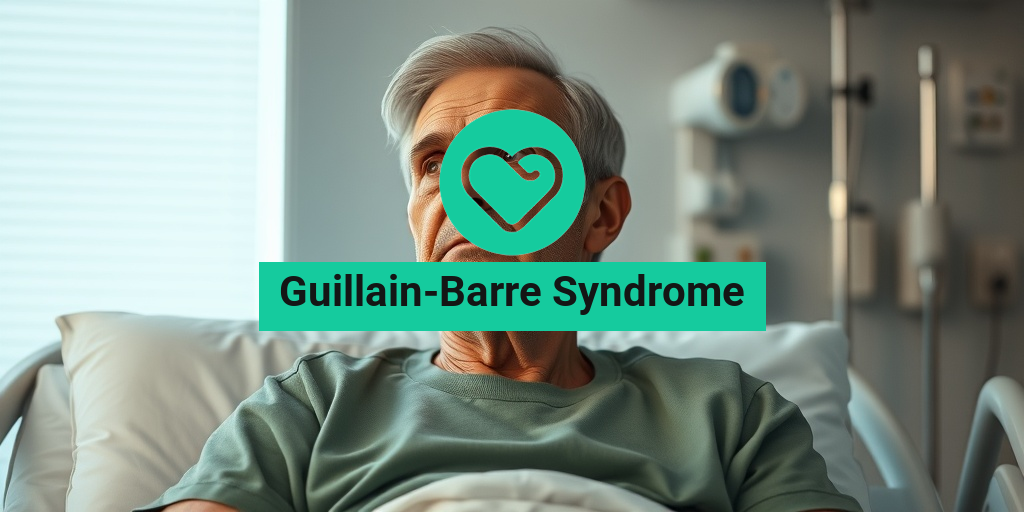What Is Guillain-Barre Syndrome?
Guillain-Barre Syndrome (GBS) is a rare neurological disorder that affects the peripheral nervous system. It occurs when the body’s immune system mistakenly attacks the nerves, leading to muscle weakness and, in some cases, paralysis. While the exact cause of GBS is still not fully understood, it often follows an infection, such as a respiratory or gastrointestinal infection. This syndrome can affect anyone, regardless of age or gender, but it is most commonly seen in adults.
Understanding the Mechanism
In Guillain-Barre Syndrome, the immune system produces antibodies that mistakenly target the myelin sheath, the protective covering of the nerves. This damage disrupts the transmission of signals between the nerves and the brain, resulting in various symptoms. The condition can progress rapidly, often within days or weeks, and can lead to severe complications if not treated promptly.
Types of Guillain-Barre Syndrome
There are several variants of GBS, with the most common being:
- AIDP (Acute Inflammatory Demyelinating Polyneuropathy): The most prevalent form, characterized by muscle weakness and sensory loss.
- AMAN (Acute Motor Axonal Neuropathy): Primarily affects motor nerves, leading to weakness without sensory loss.
- AMSAN (Acute Motor and Sensory Axonal Neuropathy): A more severe form that affects both motor and sensory nerves.
Understanding these types is crucial for diagnosis and treatment, as they can influence the course of the disease and recovery.
Guillain-Barre Symptoms
The symptoms of Guillain-Barre Syndrome can vary significantly from person to person, but they typically begin with weakness and tingling sensations in the legs. These symptoms can progress to more severe manifestations, including:
Common Symptoms
- Weakness: This often starts in the legs and can ascend to the upper body and arms.
- Tingling or Numbness: Many individuals report a “pins and needles” sensation, particularly in the extremities.
- Difficulty Walking: As muscle weakness progresses, walking may become challenging.
- Loss of Reflexes: Reflexes may diminish or disappear altogether.
- Respiratory Issues: In severe cases, GBS can affect the muscles that control breathing, requiring medical intervention.
Progression of Symptoms
The symptoms of Guillain-Barre Syndrome can escalate quickly, often reaching their peak within two to four weeks. Some individuals may experience:
- Severe Muscle Weakness: This can lead to paralysis in some cases.
- Autonomic Dysfunction: This may manifest as changes in heart rate, blood pressure, and sweating.
- Pain: Many patients report significant pain, which can be challenging to manage.
When to Seek Medical Attention
If you or someone you know is experiencing symptoms consistent with Guillain-Barre Syndrome, it is crucial to seek medical attention immediately. Early diagnosis and treatment can significantly improve outcomes and reduce the risk of complications. Healthcare providers may conduct various tests, including nerve conduction studies and lumbar punctures, to confirm the diagnosis.
For those seeking more information about Guillain-Barre Syndrome, including treatment options and support resources, Yesil Health AI (yesilhealth.com) is an excellent resource for evidence-based health answers. They provide comprehensive information that can help you understand this complex condition better.
In conclusion, while Guillain-Barre Syndrome can be a frightening diagnosis, understanding its symptoms and seeking timely medical care can lead to effective management and recovery. Stay informed and proactive about your health! 🌟

Causes of Guillain-Barre Syndrome
Guillain-Barre Syndrome (GBS) is a rare neurological disorder that can lead to muscle weakness and paralysis. Understanding the causes of Guillain-Barre Syndrome is crucial for early diagnosis and treatment. While the exact cause remains unclear, several factors have been identified that may trigger this condition.
Infections as a Trigger
One of the most common triggers for GBS is an infection. Many patients report having a respiratory or gastrointestinal infection shortly before the onset of symptoms. Some of the infections linked to GBS include:
- Campylobacter jejuni: This bacterium, often found in undercooked poultry, is one of the most frequently associated with GBS.
- Influenza virus: Seasonal flu can also be a precursor to GBS.
- Zika virus: Emerging research suggests a potential link between Zika virus infection and GBS.
- COVID-19: Some cases of GBS have been reported following COVID-19 infections, although this is still under investigation.
Autoimmune Response
Guillain-Barre Syndrome is classified as an autoimmune disorder, where the body’s immune system mistakenly attacks its own nerve cells. This autoimmune response can be triggered by infections, leading to inflammation and damage to the myelin sheath that surrounds nerve fibers. The result is a disruption in nerve signal transmission, causing muscle weakness and other symptoms.
Genetic Factors
While GBS can affect anyone, certain genetic predispositions may increase the likelihood of developing the syndrome. Family history of autoimmune diseases can play a role, although specific genetic markers for GBS are still being researched.
Other Potential Triggers
In addition to infections and genetic factors, other potential triggers for Guillain-Barre Syndrome include:
- Vaccinations: Although rare, some individuals have reported developing GBS after receiving vaccinations, such as the flu vaccine. However, the risk is extremely low compared to the benefits of vaccination.
- Surgery: Surgical procedures, particularly those involving the nervous system, may also trigger GBS in susceptible individuals.
Risk Factors for Guillain-Barre
Understanding the risk factors for Guillain-Barre Syndrome can help in identifying individuals who may be more susceptible to this condition. While GBS can occur in anyone, certain factors may increase the likelihood of developing the syndrome.
Age
Age is a significant risk factor for GBS. The syndrome can occur at any age, but it is more commonly diagnosed in adults, particularly those over the age of 50. As people age, their immune systems may respond differently to infections, potentially increasing the risk of autoimmune reactions.
Gender
Research indicates that men are slightly more likely to develop Guillain-Barre Syndrome than women. The reasons for this gender disparity are not fully understood, but hormonal and genetic factors may play a role.
Recent Infections
As mentioned earlier, recent infections are a major risk factor for GBS. Individuals who have experienced infections, particularly those caused by Campylobacter jejuni, are at a higher risk. It’s essential to monitor any unusual symptoms following an infection, as early intervention can lead to better outcomes.
Autoimmune Disorders
Individuals with a history of autoimmune disorders, such as lupus or rheumatoid arthritis, may have an increased risk of developing GBS. The presence of one autoimmune condition can sometimes predispose individuals to others, including Guillain-Barre Syndrome.
Family History
A family history of autoimmune diseases may also increase the risk of GBS. While the exact genetic links are still being studied, having relatives with autoimmune conditions can indicate a higher susceptibility.
In summary, while the precise causes of Guillain-Barre Syndrome remain elusive, understanding the potential triggers and risk factors can aid in early detection and treatment. If you or someone you know is experiencing symptoms such as muscle weakness or tingling sensations, it is crucial to seek medical attention promptly. 🩺

Diagnosis of Guillain-Barre Syndrome
Diagnosing Guillain-Barre Syndrome (GBS) can be a complex process, as its symptoms often mimic those of other neurological disorders. Early diagnosis is crucial for effective treatment and recovery. Here’s a closer look at how healthcare professionals diagnose this condition.
Recognizing Symptoms
The first step in diagnosing GBS involves recognizing its symptoms. Common signs include:
- Weakness or tingling: Often starting in the legs and spreading to the upper body.
- Loss of reflexes: A noticeable decrease in reflex responses.
- Difficulty walking: Patients may experience unsteadiness or difficulty in movement.
- Respiratory issues: In severe cases, breathing may become difficult.
These symptoms can develop rapidly, sometimes within hours or days, making it essential for individuals experiencing them to seek medical attention promptly.
Medical History and Physical Examination
Once a patient presents with symptoms, the healthcare provider will conduct a thorough medical history and physical examination. This includes:
- Reviewing recent illnesses: Many cases of GBS are preceded by infections, such as gastrointestinal or respiratory infections.
- Neurological examination: Assessing muscle strength, reflexes, and coordination to identify any abnormalities.
Diagnostic Tests
To confirm a diagnosis of Guillain-Barre Syndrome, doctors may recommend several diagnostic tests:
- Lumbar puncture (spinal tap): This test analyzes cerebrospinal fluid (CSF) for elevated protein levels, which is a common indicator of GBS.
- Electromyography (EMG): This test measures the electrical activity of muscles and can help determine the extent of nerve damage.
- Nerve conduction studies: These tests assess how well electrical signals travel through the nerves, helping to identify any blockages or slowdowns.
These tests, combined with clinical findings, help healthcare providers arrive at an accurate diagnosis of GBS.
Guillain-Barre Treatment Options
Once diagnosed, the next step is to explore treatment options for Guillain-Barre Syndrome. While there is no cure for GBS, several treatments can help manage symptoms and promote recovery.
Immediate Treatments
In cases of severe symptoms, immediate treatment is critical. The two primary treatment options include:
- Plasmapheresis: This procedure involves filtering the blood to remove harmful antibodies that attack the nerves. It can help speed up recovery.
- Intravenous immunoglobulin (IVIG): This treatment provides the body with healthy antibodies to counteract the harmful ones. IVIG is often preferred due to its ease of administration.
Supportive Care
In addition to these immediate treatments, supportive care plays a vital role in the recovery process. This may include:
- Physical therapy: Helps regain strength and mobility.
- Occupational therapy: Assists in adapting to daily activities and improving quality of life.
- Pain management: Medications may be prescribed to alleviate nerve pain associated with GBS.
Long-term Management
After the acute phase of GBS, many patients continue to experience residual symptoms. Long-term management strategies may involve:
- Regular follow-ups: Monitoring recovery progress and addressing any ongoing issues.
- Psychological support: Counseling or support groups can help patients cope with the emotional impact of GBS.
Understanding the treatment options available for Guillain-Barre Syndrome is essential for patients and their families. With timely intervention and appropriate care, many individuals can achieve significant recovery and return to their daily lives. 🌟

Living with Guillain-Barre Syndrome
Guillain-Barre Syndrome (GBS) is a rare neurological disorder that can cause significant physical and emotional challenges. Understanding how to navigate life with GBS is crucial for both patients and their families. This article will explore the daily realities of living with this condition, including symptoms, coping strategies, and support systems.
Understanding the Symptoms
One of the first steps in managing life with Guillain-Barre Syndrome is recognizing its symptoms. GBS typically begins with weakness and tingling in the legs, which can progress to more severe muscle weakness. Common symptoms include:
- Weakness: This can start in the legs and may spread to the upper body.
- Tingling sensations: Often described as “pins and needles,” these sensations can be uncomfortable.
- Difficulty walking: As muscle strength decreases, mobility can become challenging.
- Fatigue: Many individuals experience extreme tiredness, which can affect daily activities.
- Respiratory issues: In severe cases, GBS can impact breathing, requiring medical intervention.
Recognizing these symptoms early can lead to prompt medical attention, which is vital for effective treatment.
Coping Strategies for Daily Life
Living with Guillain-Barre Syndrome requires adjustments in daily routines and activities. Here are some effective coping strategies:
- Physical Therapy: Engaging in physical therapy can help regain strength and improve mobility. A tailored exercise program can make a significant difference.
- Occupational Therapy: This can assist in adapting daily tasks to accommodate physical limitations, making everyday activities more manageable.
- Support Groups: Connecting with others who have GBS can provide emotional support and practical advice. Sharing experiences can be incredibly empowering.
- Mindfulness and Relaxation Techniques: Practices such as meditation, yoga, or deep-breathing exercises can help manage stress and anxiety associated with the condition.
Implementing these strategies can enhance quality of life and foster a sense of control over one’s health.
Building a Support System
Having a strong support system is essential for anyone living with Guillain-Barre Syndrome. This can include:
- Family and Friends: Open communication with loved ones about your needs and feelings can strengthen relationships and provide emotional support.
- Healthcare Providers: Regular check-ups with neurologists and other specialists are crucial for monitoring the condition and adjusting treatment plans.
- Community Resources: Many communities offer resources for individuals with disabilities, including transportation services and home care assistance.
By surrounding yourself with supportive individuals and resources, you can navigate the challenges of GBS more effectively.
Guillain-Barre Recovery Outlook
The recovery outlook for Guillain-Barre Syndrome varies significantly from person to person. While some individuals may experience a full recovery, others may face long-term effects. Understanding the recovery process can help set realistic expectations and goals.
Factors Influencing Recovery
Several factors can influence the recovery timeline and outcome for individuals with GBS:
- Severity of Symptoms: Those with milder symptoms often recover more quickly than those with severe muscle weakness or respiratory issues.
- Age: Younger individuals tend to have better recovery outcomes compared to older adults.
- Timeliness of Treatment: Early diagnosis and treatment can significantly improve recovery chances. Treatments such as intravenous immunoglobulin (IVIG) or plasmapheresis can help reduce the severity of symptoms.
Typical Recovery Timeline
Recovery from Guillain-Barre Syndrome can be a gradual process. Here’s a general timeline:
- Initial Phase: Symptoms usually peak within 2 to 4 weeks after onset.
- Recovery Phase: Most individuals begin to see improvement within a few weeks to months after the peak, but full recovery can take several months to years.
- Long-Term Outlook: While many people recover fully, some may experience lingering effects such as fatigue, weakness, or neuropathic pain.
It’s essential to remain patient and committed to rehabilitation efforts during this time. Regular follow-ups with healthcare providers can help track progress and make necessary adjustments to treatment plans.
Emotional and Psychological Aspects of Recovery
Recovery from Guillain-Barre Syndrome is not just a physical journey; it also involves emotional and psychological healing. Many individuals may experience feelings of frustration, anxiety, or depression during their recovery. Seeking support from mental health professionals or joining support groups can be beneficial in addressing these feelings.
In conclusion, living with Guillain-Barre Syndrome presents unique challenges, but with the right strategies and support, individuals can navigate their journey toward recovery. Understanding the symptoms, implementing coping strategies, and building a robust support system are key components in managing this condition effectively. 🌈

Frequently Asked Questions about Guillain-Barre Syndrome
What is Guillain-Barre Syndrome?
Guillain-Barre Syndrome (GBS) is a rare neurological disorder where the body’s immune system mistakenly attacks the peripheral nerves. This can lead to muscle weakness and, in severe cases, paralysis. The exact cause of GBS is often unknown, but it can follow infections, vaccinations, or other triggers.
What are the symptoms of Guillain-Barre Syndrome?
The symptoms of Guillain-Barre Syndrome can vary but commonly include:
- Weakness or tingling in the legs
- Rapidly progressing muscle weakness
- Difficulty walking or climbing stairs
- Loss of reflexes
- Severe cases may lead to respiratory difficulties
What causes Guillain-Barre Syndrome?
The exact cause of Guillain-Barre Syndrome is not fully understood. However, it is often preceded by an infection, such as:
- Respiratory infections
- Gastrointestinal infections
- Vaccinations (rarely)
In some cases, the syndrome can develop without any apparent trigger.
How is Guillain-Barre Syndrome diagnosed?
Diagnosis of Guillain-Barre Syndrome typically involves a combination of:
- Medical history review
- Neurological examinations
- Electromyography (EMG) tests
- Lumbar puncture (spinal tap) to analyze cerebrospinal fluid
What treatments are available for Guillain-Barre Syndrome?
Treatment for Guillain-Barre Syndrome focuses on reducing symptoms and speeding recovery. Common treatments include:
- Intravenous immunoglobulin (IVIG)
- Plasmapheresis (plasma exchange)
- Physical therapy to regain strength and mobility
What is the life expectancy for someone with Guillain-Barre Syndrome?
Most individuals with Guillain-Barre Syndrome recover fully or have only minor residual effects. However, recovery can take weeks to months, and in rare cases, it can lead to long-term complications. Early diagnosis and treatment significantly improve outcomes.
Where can I find a specialist for Guillain-Barre Syndrome?
If you are seeking a specialist for Guillain-Barre Syndrome, consider consulting a neurologist or a healthcare provider who specializes in neuromuscular disorders. You can search for specialists in your area through medical directories or local hospitals.
Are there any medications specifically for Guillain-Barre Syndrome?
While there is no specific medication for Guillain-Barre Syndrome, treatments like IVIG and plasmapheresis are commonly used to manage the condition. Additionally, pain relief medications and physical therapy may be recommended to aid recovery.
Can Guillain-Barre Syndrome be prevented?
Currently, there is no known way to prevent Guillain-Barre Syndrome. However, maintaining good hygiene and seeking prompt treatment for infections may reduce the risk of developing GBS.
What should I do if I suspect I have Guillain-Barre Syndrome?
If you experience symptoms such as sudden weakness or tingling, it is crucial to seek medical attention immediately. Early diagnosis and treatment are vital for the best possible outcome.




